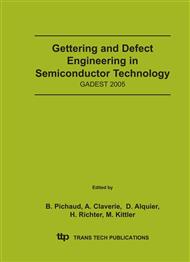p.187
p.193
p.199
p.205
p.211
p.217
p.223
p.229
p.235
Evolution of Hydrogen Related Defects in Plasma Hydrogenated Crystalline Silicon under Thermal and Laser Annealing
Abstract:
Boron doped [100]-oriented Cz Si wafers are hydrogenated with a plasma enhanced chemical vapor deposition setup at a substrate temperature of about 260 °C. In-situ Raman spectroscopy is applied on samples under thermal and laser annealing. It is found that different Si-H species have different stabilities. The most stable one is the Si-H bond at the inner surfaces of the platelets. The dissociated energy of Si-H bonds is deduced based on the first order kinetics. It is found that the hydrogen atoms which are released during annealing are trapped again by the platelets and passivate the silicon dangling bonds at the inner surfaces of the platelets or form H2 molecules in the open platelet volume, possibly relating to the basic mechanism of the hydrogen-induced exfoliation of the silicon wafer and the socalled “smart-cut” process.
Info:
Periodical:
Pages:
211-216
Citation:
Online since:
December 2005
Authors:
Price:
Сopyright:
© 2005 Trans Tech Publications Ltd. All Rights Reserved
Share:
Citation:


